How to produce and arrange orchestral sounds: Woodwind & Brass
In the second part of our series, we continue our beginner’s guide to orchestrating with your DAW. This month, we turn our attention to woodwind and brass…
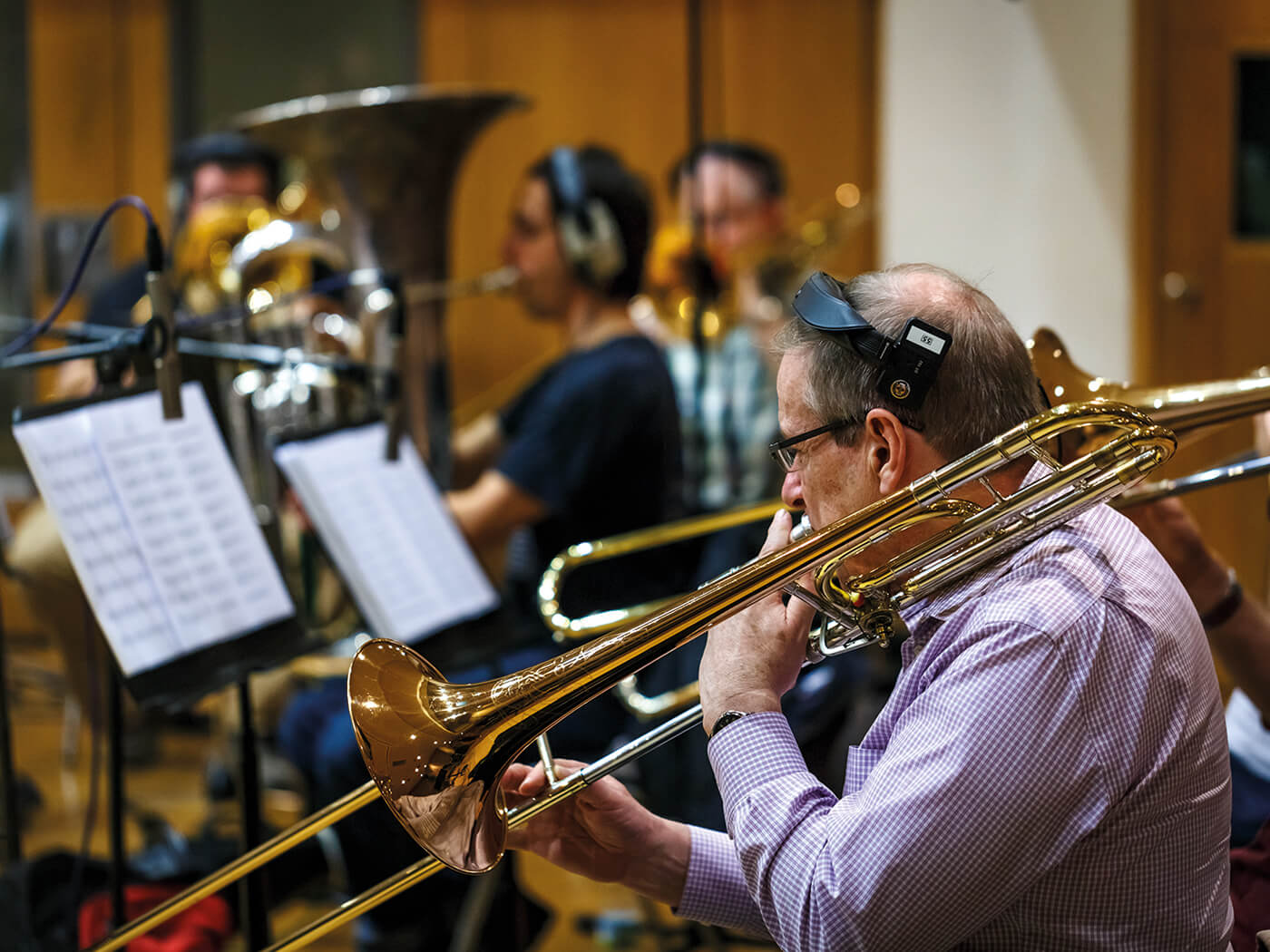
Image: Spitfire Audio
The two areas of the orchestra that arguably provide the greatest degree of timbral colour are the woodwind and brass sections. The former offers four very distinct instruments, which can sound very different, and one of them isn’t even made of wood. The brass section, however, offers a roughly similar tonal colour, with degrees of bright and mellow, which can be used to great effect to shore up those action sequences, and more besides.
Let’s start by looking at the woodwind section, from the top downward. The highest instrument in the section is the flute, and it’s something of a contradiction. While it was traditionally a wooden instrument, just about all flutes (at least of the orchestral variety) are now made of metal, making it the odd-one-out in this instrumental family.
Flute players produce a tone by blowing across a hole at one end of the instrument, and where the original wooden flutes would have had basic finger holes, which the player would cover to get a different note, modern flutes use keys. The reason for this is largely down to reliability when covering the pitch holes, as the keys have pads on the underside to create a better seal than that possible with a finger.
Read part one of our Orchestral Manoeuvres series where we covered strings.
Fowl play
Where flutes can sound high, bright and chirpy, the next instrument down, the
oboe, can often sound darker, but with exaggerated harmonic overtones. The oboe can also play reasonably high and will sound less bright within this register when compared to the flute, while sounding more sonorous in the lower part of its register. The oboe’s tonal colour is sometimes quite unfairly compared to the sound of a duck, possibly because of the use of a double reed to obtain its initial sound.
The two reeds vibrate in parallel, a little like the voice boxes of water fowl, which might explain the very slight similarity and the comparison. Thankfully, though, the oboe can sound far more musical than any duck call. Using the flute and the oboe together to play a unison line can make for a very useful instrumental colour, and is often described as a ‘fl-oboe’.
The next instrument in line is the clarinet, which offers quite a hollow and altogether darker timbral colour, quite similar in harmonic content to the square wave, as used in subtractive synthesis. Every other harmonic is missing, hence the slightly hollow sound, but don’t think of this as a negative point, as it has a vast note and dynamic range, and can sound mellow and cool, making it a favourite for use in jazz. Use it alongside an oboe in a unison line and you have yourself a cl-oboe.
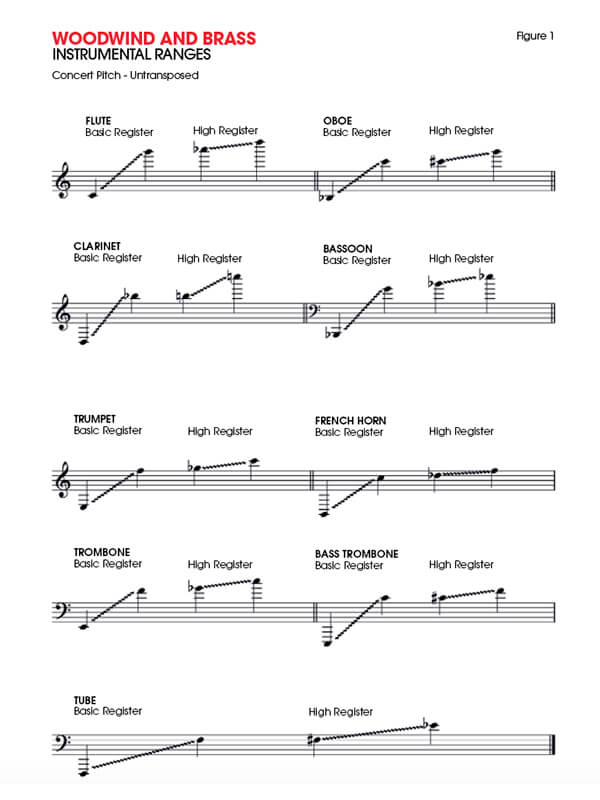
Finally, to the lowest of the wind brethren, the bassoon has similar tonal characteristics to the oboe, because it also uses a double-reed system. However, being pitched considerably lower, it doesn’t suffer the same accusations of mallardry. It’s a great instrument for shoring up the bottom end of a chord, with a register that can go pretty low.
Two things that all of these wind instruments have in common is they all require the player to take a deep breath and blow, and notes are changed by using all fingers and thumbs to block or uncover a hole on the instrument. Because they require the use of all 10 digits, they can all be played with a huge degree of agile dexterity, allowing for both speed of movement from one note to the next and the ability to leap around.
However, as with all instruments, there are certain instrument-dependent limitations that vary according to key and what you’re asking the player to do. The other obvious point is that while they don’t require a huge amount of breath to get a note, players cannot play a note forever, as they will eventually run out of breath.
There is a technique known as circular breathing, which is usually adopted by players of the didgeridoo, but it’s not a common technique that all wind players have mastered, given that it’s both difficult to achieve and rarely required. Don’t write notes that play for a minute; it’ll be obvious that it’s not a real player!
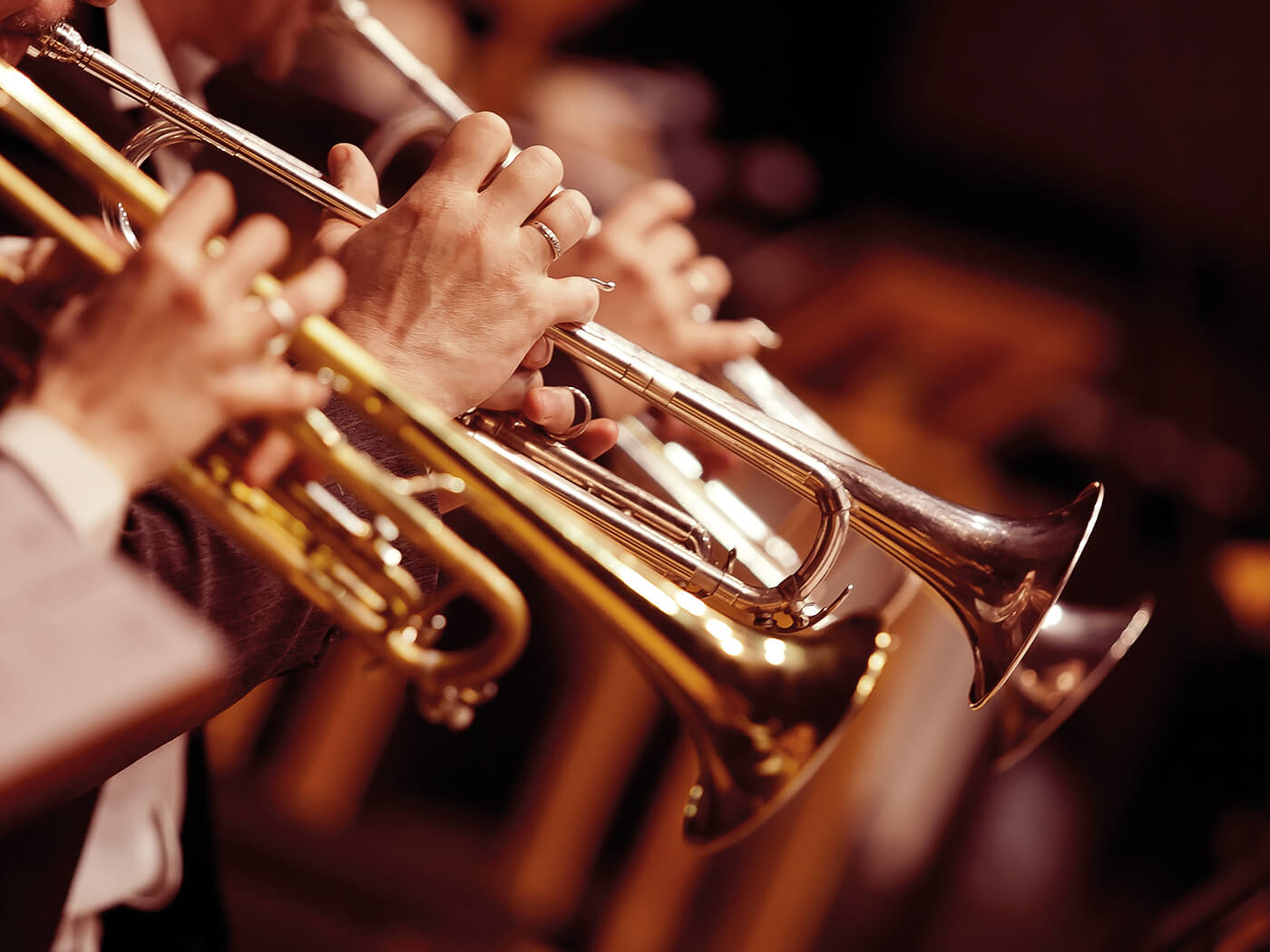
Acoustic musical instruments, just like electronic ones, have evolved over time. And with this progression, the woodwind family has grown way beyond the basic family group. Bass clarinets, contrabassoons and alto flutes are all regarded as extensions to the more commonplace and steadfast family members, and while incredibly popular in contemporary music and film scoring, can quickly clutter up an orchestration if you don’t know what you’re doing.
So without wishing to seem like a killjoy, it’s probably a good idea to steer clear of these instruments until you have a greater understanding of the basics. One of the most traditional and sensible ways to use woodwinds is as a double section, which means you’ll have two of each instrument. This is very firmly the woodwind construct from the Western classical era of music onwards. Think Beethoven, and you’ll be on the right track!
Brass tracks
The other family of instruments which requires the player to blow is the brass family. Unlike the woodwinds, and as the name suggests, these instruments are made entirely from metal. The sound of a brass instrument is generated by the player generating a buzz with their lips into a conical mouthpiece, which in turn creates a vibration in the column of air down the instrument.
Brass instruments are pretty directional in sound, as the resulting noise always emits from the bell of the instrument They can also play very loud, but the louder they play, the less time they can sustain sound for in the space of one breath.
As notes are generated via buzzing of the lips, brass players can suffer from fatigue while playing. Where strings can play for hours at a time, it’s unlikely that brass players can match them for stamina, unless they are right at the top of their field. Just as with running a marathon, players have to be match-fit in order to be at their best and they’ll be able to sound and play better as a result. Generally speaking, the higher and louder you ask players to play, the less time they can play for overall.
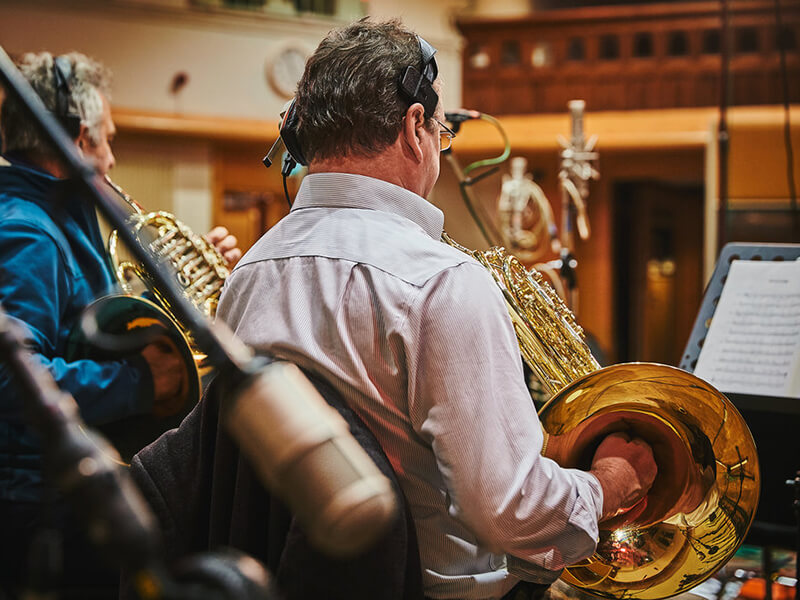
As a family, brass instruments all employ the harmonic series, which is the naturally occurring set of overtones found in all timbre, to a greater or lesser extent. This creates a wall of notes which a player can call upon. The player then picks out the note they want, by tightening or loosening their lips, which in turns makes the ‘buzz’ go higher or lower.
As the notes of the harmonic series are aligned as what we would hear as a major chord, it’s up to the player to employ valves to shift each harmonic sequence down a semitone, to make all the notes of a scale available. It all sounds very complicated, but does becomes second nature with practice.
As with woodwinds, there is a basic construct of four instruments which go to make up a traditional brass section, starting with the highest instrument, which is the trumpet. Using a small mouthpiece, the trumpet can call upon a comfortable range of just over two octaves, with higher notes being available with better players.
Some players, particularly within the jazz and session/soundtrack worlds have the ability to play very high, and at volume. This, when coupled with the general brightness and capable volume of the instrument can really add something exciting to a score.
The next instrument down in the section is the French horn, which is easily identified as the instrument with lots of tubing curled into a swirling circle. This instrument also requires the player to stick their hand up the bell of the instrument to support it. Horns have a very mellow sound, and can be especially effective when playing together in unison and, just like trumpets, French horns are equipped with three valves.
The next instrument in descending order is the trombone, and is the odd brass instrument out as it is one of the only musical instruments which does not require finger dexterity to play. Using a much bigger mouthpiece than both the horn and the trumpet, the trombone uses a slide instead of valves to move from one note to the next, or more accurately, move from one harmonic sequence to the next. The slide also means that it is capable of sweeping rips and glissando, making it perfect for comedic moments, where glissandos might be employed.
To further add to the trombone section, it’s the norm to use a bass trombone, which is in essence identical to the more usual tenor trombone, but is slightly larger in bore size, making it more sombre sounding and suited to playing lower notes. Hence, in most orchestral trombone sections, you would find two tenor trombones and a bass trombone.
Apart from its perfect ability to play lower more comfortably, the bass trombone also forms the perfect bridge to the lowest instrument in the section, called the tuba. It’s fair to say that there is a degree of commitment to playing the tuba: it’s so big, it requires strength to simply move it around or hold it! Not surprisingly, it requires a great deal of puff to play, but will sound beautifully sonorous when placed at the bottom of the section.
Brass 11, Strings 48
The most common size of a contemporary orchestral brass section would consist of three trumpets, four horns, three trombones (consisting of two tenors and a bass) and one tuba. This sounds balanced as a section, while being capable of playing very loud, particularly when compared to the string section – which although considerably larger in size, can be matched or exceeded in volume by only 11 brass players in a live context.
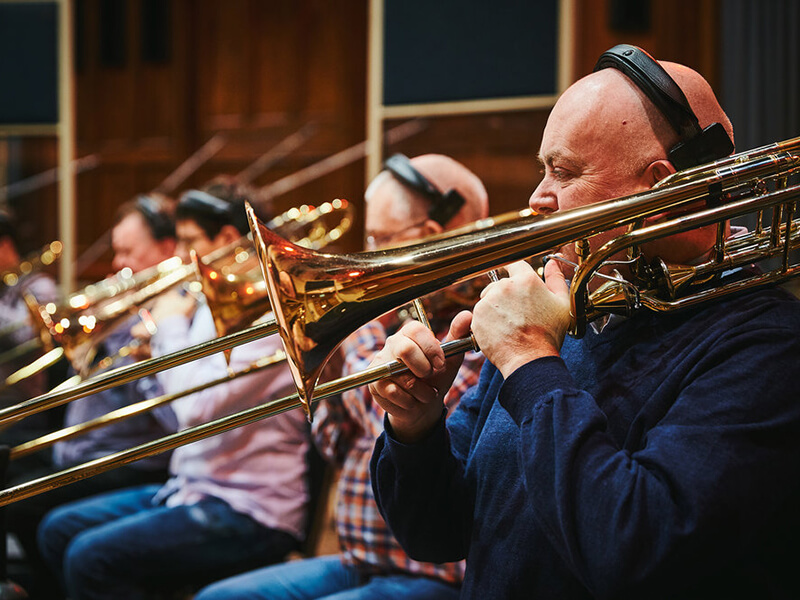
Brass can perform really well in a variety of settings; think heraldic fanfares and you’ll not be far from one of the fortes of the brass section. Trumpets can be especially good at bolstering melodies, at both the loud and quiet ends of the spectrum, while horns have become something of a melodic calling card for composers such as Hans Zimmer. The trombone and tuba section can add tremendous sonority to a track, by doubling the harmony in the middle registers, while providing a huge foundation to the bottom end of the harmony.
Making connections
As you can see from the instrumental-ranges chart (see Figure 1), there is a fair degree of crossover as one instrumental range infiltrates another. This means that when building up chords with winds, interesting timbral colours can be created if you interconnect one instrument carefully with another.
Possibly the first question to ask is: where do you want to use these winds and brass instruments? Winds can be fantastic for playing melodies or shoring up chords, while the lower winds can also add a healthy colour to a bassline. Adding a bassoon to double a cello line can also add an interesting timbre, but we’ll start by looking at constructing a sustained chord.
If you caught the first part of our Orchestral Manoeuvres feature on strings, you might remember we referenced the composer JS Bach, whose helpful guidelines for constructing a coherent chord voicing can prove really useful. The same can be considered the case with wind and brass instruments, but as these instruments might often be used to emphasise specific areas within a piece, you can safely use more notes, particularly when placed higher in pitch.
The more you enter the lower/bass register, the more you will want to thin out the number of notes that you use. If you’re new to this, a good place to start is by doubling the root note of any given chord, possibly in octaves.
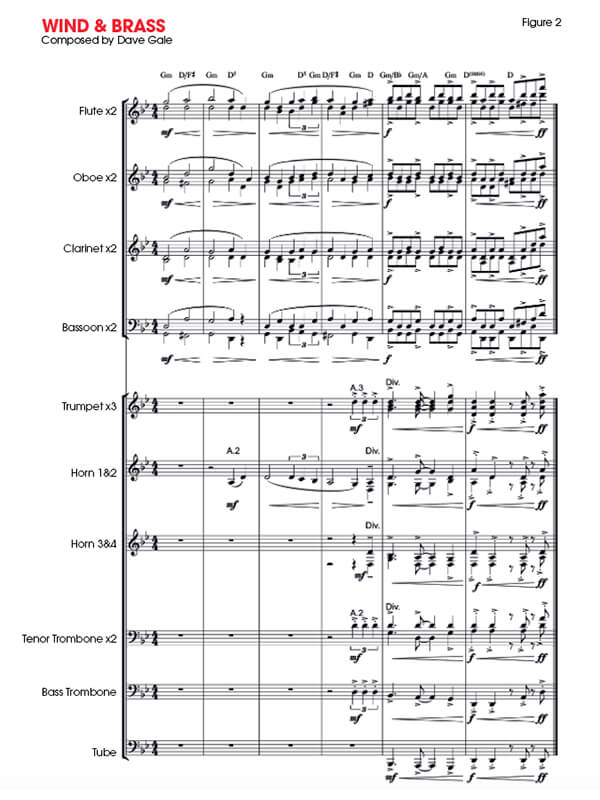
The first two bars of Figure 2 give us a good indication of the way that we might approach this; you can clearly see that the first chord is stacked with more notes in the upper register than the lower. Just as we mentioned in our strings tutorial, part leading can also be an important consideration, as also demonstrated in the first four bars, but winds are very good at jumping around, and can be really effective if used in this way.
The last two bars demonstrate how the woodwinds can be exploited to both jump around and also accent certain notes, to create further excitement. The accents are indicated by the arrow heads above certain notes.
The addition of the brass in the last couple of bars also increases the overall tension and excitement, by way of a crescendo in dynamic range, adding a brightness of colour which will sound huge and engaging. Notice that the sustained rhythm is accented, with shorter notes in the last bar, which are often described as ‘stabs’. The whole excerpt increases to a vast crescendo, which will sound even more impressive once the strings and percussion are imported alongside.
The brass, or more significantly the French horns, have an entry in bar 2 which could be considered a counter-melody; the concept behind this is often to add a second element to an existing melody, and can be easily achieved by making the counter-line move in an opposite direction to a melody. The main bulk of the brass section enters halfway through bar 4, with a unison fanfare-style repetition of three notes. This will make a big statement, and is exactly the kind of thing that the brass will do really well.
Opening the DAW to wind and brass
Traditionally, wind and brass instruments have always been among the most difficult to emulate in sampled form. We have better samples now than we have ever had, thanks to the rise in the technology which has made multi-layered sampling a commonplace feature.
The first and biggest point to make is that it is really important to try and think like the instrumentalist might, when playing from a keyboard. As we mentioned, wind and brass players have to breathe, often dictated by the length of phrase. If you think in phrases, rather than simply randomly lifting off the note when you feel like it, a better and more coherent overall effect can be created.
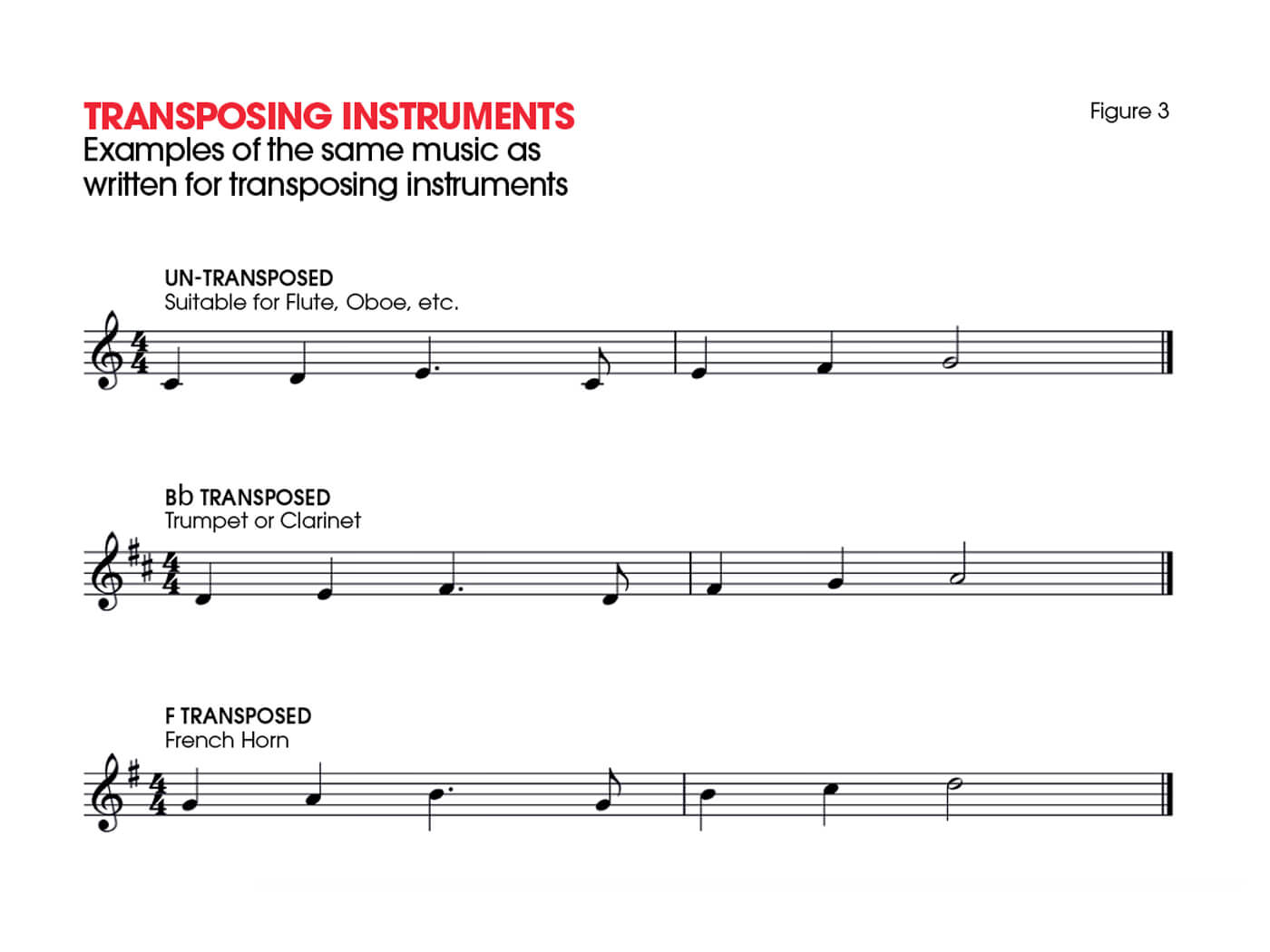
As we discussed when working with strings, it is often a good idea to work with individual lines, so that you can create that smoothness of line that we refer to as a legato. It’s also a terrific idea to pepper any woodwind lines with the occasional detached or staccato note, rather than simply playing a shorter note with a legato sample.
Just about all sampling companies go to great lengths to capture the sounds of players playing notes in different ways, and the use of keyswitching will almost undoubtedly result in a more believable effect, with the use of appropriate sampled articulations. Most packages also offer control of dynamics via the mod wheel (MIDI CC 1) meaning that phrases can rise and fall in volume, sounding far more believable as a consequence.
Brass sections are excellent at adding stab-like effects, that inject real excitement into a composition, but will be far more effective if used sparingly. As demonstrated by many film composers, French horns sound superb playing sweeping melodies or counter-melodies, but you might need to work with the sample to get them to sit in your mix.
Not only can French horns be overpowering, but they can also sound slightly behind the beat, thanks to their bells facing toward the rear. When composing in a DAW, do not be afraid to shift entire phrases forward onscreen in order to get them to play in time.
The final score
Using wind and brass in your compositions is not a prerequisite. I’d be lying if I said I used them all the time – in fact, it very firmly depends on context and what it is you are writing, and for many, the use of strings is a far more enticing and valuable prospect. But winds and particularly brass can inject something into a track which would just sound lacklustre without them. All those action films with big brash scores use wind and brass to epic effect, and it’s only when they’re not present that you realise how much you miss them.
Of course, this doesn’t mean that you should use wind and brass all the time. Instead, think of them as a form of musical seasoning which can be sprinkled liberally across a track when nothing else can command the action. Can you honestly imagine the theme to Star Wars without the opening brass fanfare, or all of those fast runs in the woodwinds? No, neither can I.
Product highlights
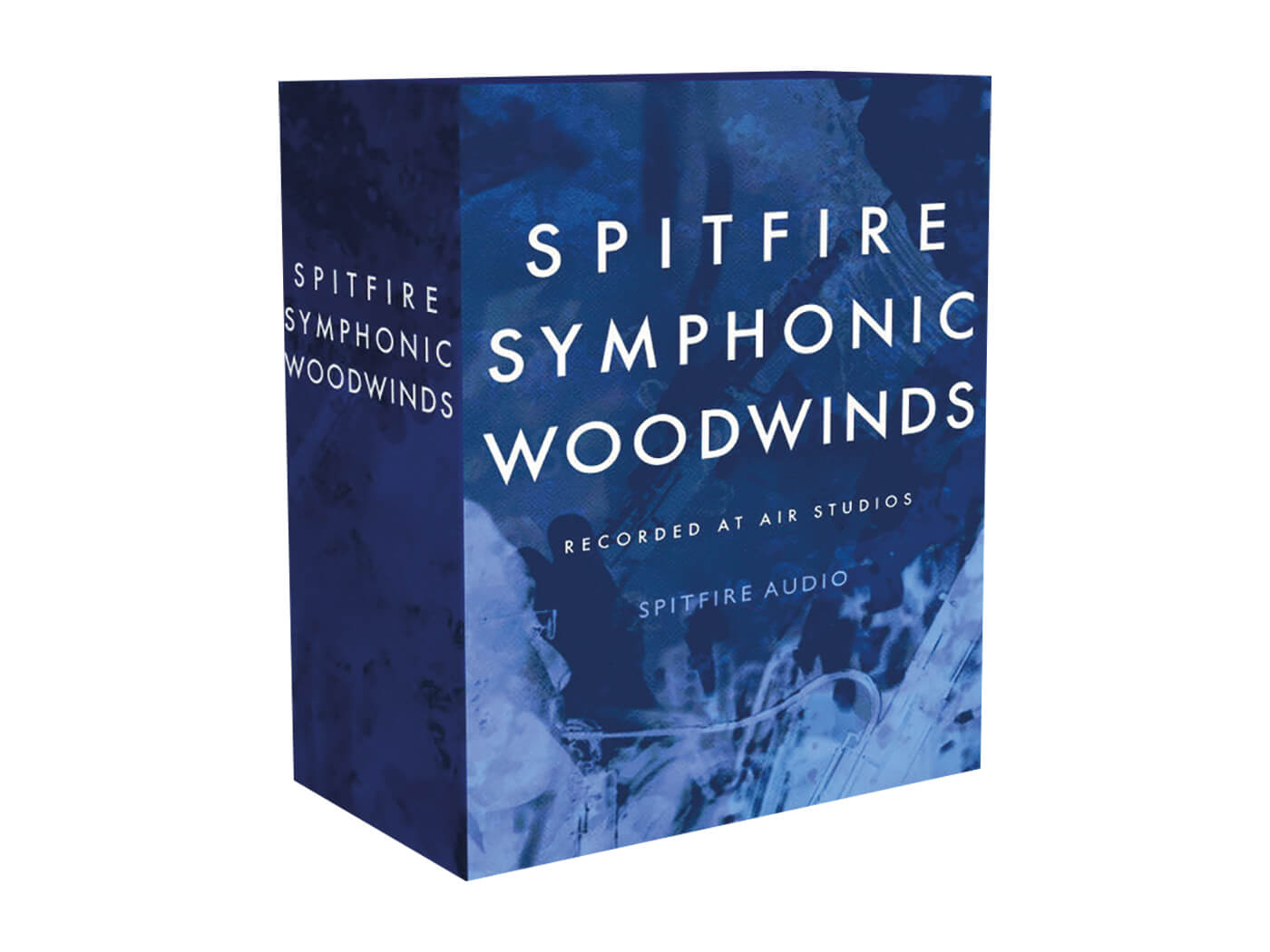
Spitfire Audio
Symphonic Woodwinds Symphonic Brass £549/£599
Being one of the market leaders and main players in the orchestral-sample field, Spitfire has all bases covered. These were both recorded in the Lyndhurst Hall at AIR studios. Firmly exploiting the instrumentation in place, they sound excellent for full-on orchestral duties with a host of articulation, including some superb brass stabs, which sound unbelievably effective.
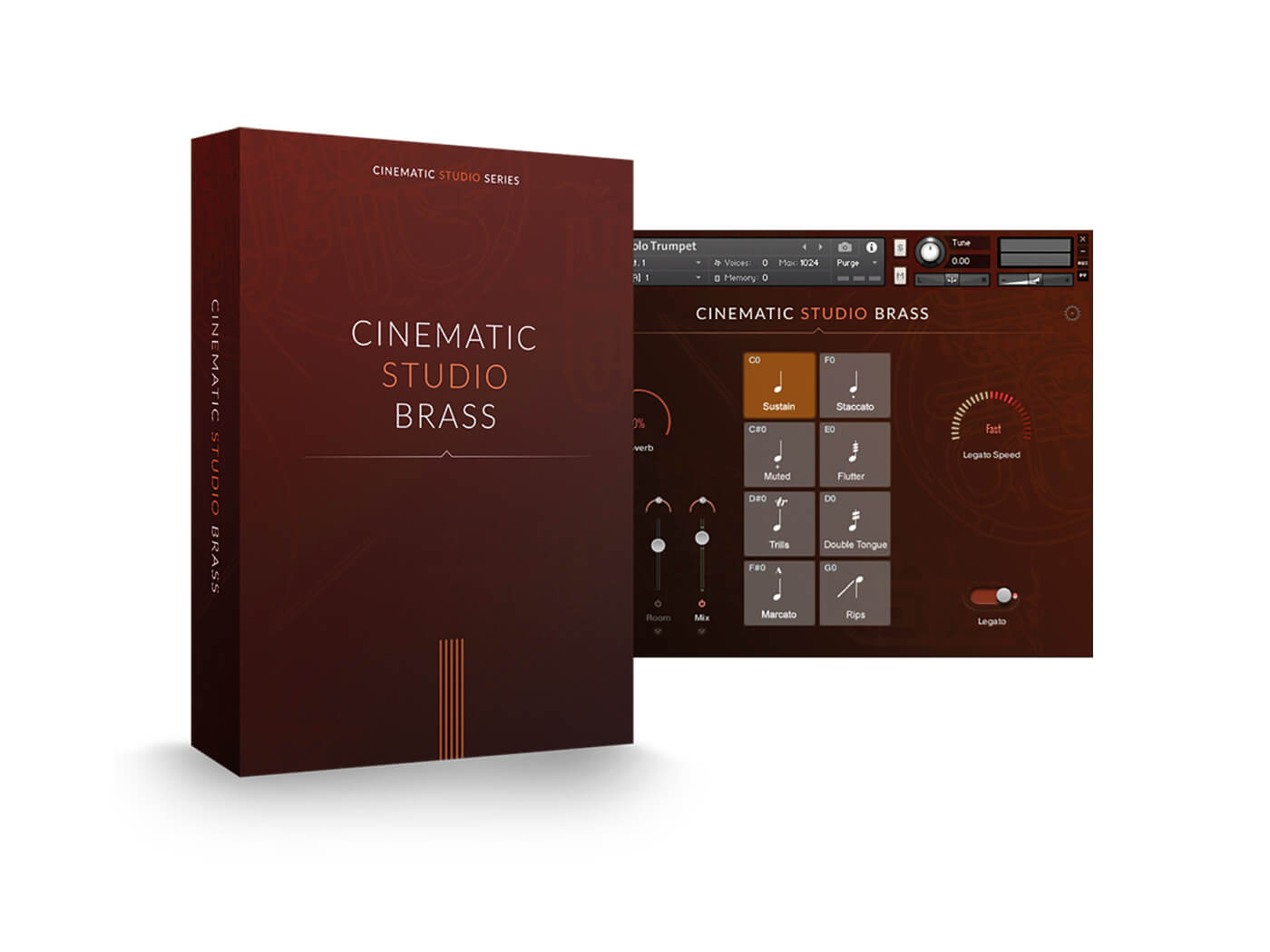
Cinematic Studio Series
Cinematic Studio Brass $399
New to the market, CSB is recorded on a dry studio stage, with an interface which is something of a game changer. It’s very easy to use and work with and a boon for anyone who needs good workflow. The drier and more filmic acoustic lends itself beautifully to commercial work, allowing for ease of addition of onboard reverb, should it be required.
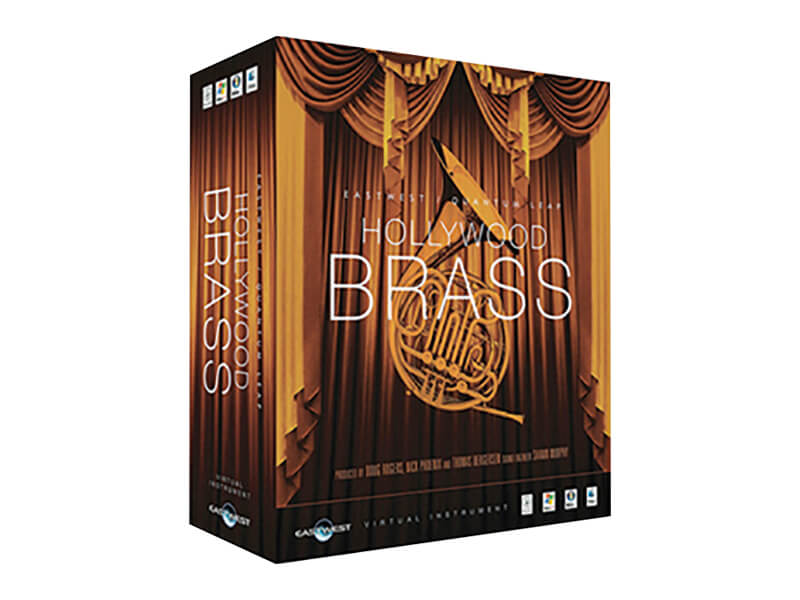
EastWest Sounds
Hollywood Orchestral Woodwinds/Hollywood Brass $399/$399
Both of these editions are popular classics with media composers, and for very good reason. They cover the basic remit of wind and brass and go way beyond. While they’re sensibly priced, they’re both available as part of the Composer Cloud subscription package, which keeps the cost affordable and flexible.